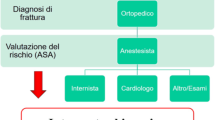Summary.
Since 1993 a report card system for fractures of the neck of the femur has been established in the Department of External Quality Assurance of the Chamber of Physicians of Westphalia-Lippe. Several indicators of good quality have changed significantly since then: conservative treatment decreased from 6.8 % in 1993 to 4.2 % in 1997, lethality decreased from 6.9 % to 5.4 %, average length of stay decreased from 30.9 days to 24.9 days, average length of stay before operation decreased from 2.6 to 2.1 days, the frequency of operations on weekends increased, complications in wound healing increased from 4.9 to 6.0 %, and cardiopulmonary complications decreased from 11.2 % to 7.8 %. Between 1993 and 1997, 54.3 % were dismissed to go home; the percentage of patients sent to rehabilitation facilities after acute care rose from 8.3 % in 1993 to 20.1 % in 1997. The most frequent and still increasing procedure was implantation of hemiprosthesis/bipolar prosthesis (from 38.8 % in 1993 to 41.0 % in 1997) followed by total hip replacement (decreasing from 37.4 % in 1993 to 34.2 % in 1997). Operative treatment was performed in more than 90 % of all fractures in all counties of Westphalia-Lippe. However, there was a wide and significant geographical variation in the choice between osteosynthesis and hip replacement: the percentage of hip replacements differed between 57 % and 82 % among different counties. Average length of stay before the operative procedure for patients undergoing reduction and rigid internal fixation of the fracture is still too long (1.6 days in 1997).
Zusammenfassung.
Zwischen dem 1. 1. 1993 und dem 31. 12. 1997 wurden über die Tracerdiagnose „Oberschenkelhalsfraktur“ der externen Qualitätssicherung Chirurgie der Ärztekammer Westfalen-Lippe 22 556 Patientenverläufe dokumentiert. Mehrere Qualitätsindikatoren unterlagen im Beobachtungszeitraum signifikanten Veränderungen: die konservative Behandlung nahm von 6,8 % 1993 auf 4,2 % 1997 ab, die Letalität nahm von 6,9 % auf 5,4 % ab, die mittlere Verweildauer nahm von 30,9 Tagen auf 24,9 Tage ab, die mittlere präoperativen Liegezeit im Krankenhaus nahm von 2,6 Tagen auf 2,1 Tage ab, die Operationstätigkeit am Wochenende nahm zu, Wundheilungsstörungen nahmen von 4,9 % auf 6,0 % zu, kardiopulmonale Komplikationen nahmen von 11,2 % auf 7,8 % ab. Von 1993 bis 1997 wurden insgesamt 54,3 % der Patienten nach Hause entlassen; der Anteil der Patienten, die nach dem Aufenthalt in einem Akutkrankenhaus in eine Rehabilitationseinrichtung verlegt wurden, nahm von 8,3 % 1993 auf 20,1 % 1997 zu. Führendes Implantat mit leicht ansteigender Tendenz ist die Femurkopfprothese/Duokopfprothese (von 38,8 % 1993 auf 41,0 % 1997) vor der Totalendoprothese (TEP) (Abfall von 37,4 % 1993 auf 34,2 % 1997). Während die Indikation für eine operative Behandlung mit über 90 % in allen Kreisen in Westfalen-Lippe einheitlich gestellt wird, unterliegt die Anwendung der verschiedenen Operationsverfahren einer erheblichen geographischen Variation. So schwankt der Anteil endoprothetischer Versorgung je nach Region zwischen 57 % und 82 %. Die präoperative Liegezeit im Krankenhaus bei femurkopferhaltenden Operationen ist trotz einer ständigen Verringerung mit durchschnittlich 1,6 Tagen im Jahr 1997 noch zu lang.
Similar content being viewed by others
Author information
Authors and Affiliations
Rights and permissions
About this article
Cite this article
Smektala, R., Wenning, M. & Ekkernkamp, A. Schenkelhalsfraktur: Analyse der Ergebnisse externer Qualitätssicherung Ein Bericht über 22 556 Patienten. Chirurg 70, 1330–1339 (1999). https://doi.org/10.1007/s001040050788
Issue Date:
DOI: https://doi.org/10.1007/s001040050788




